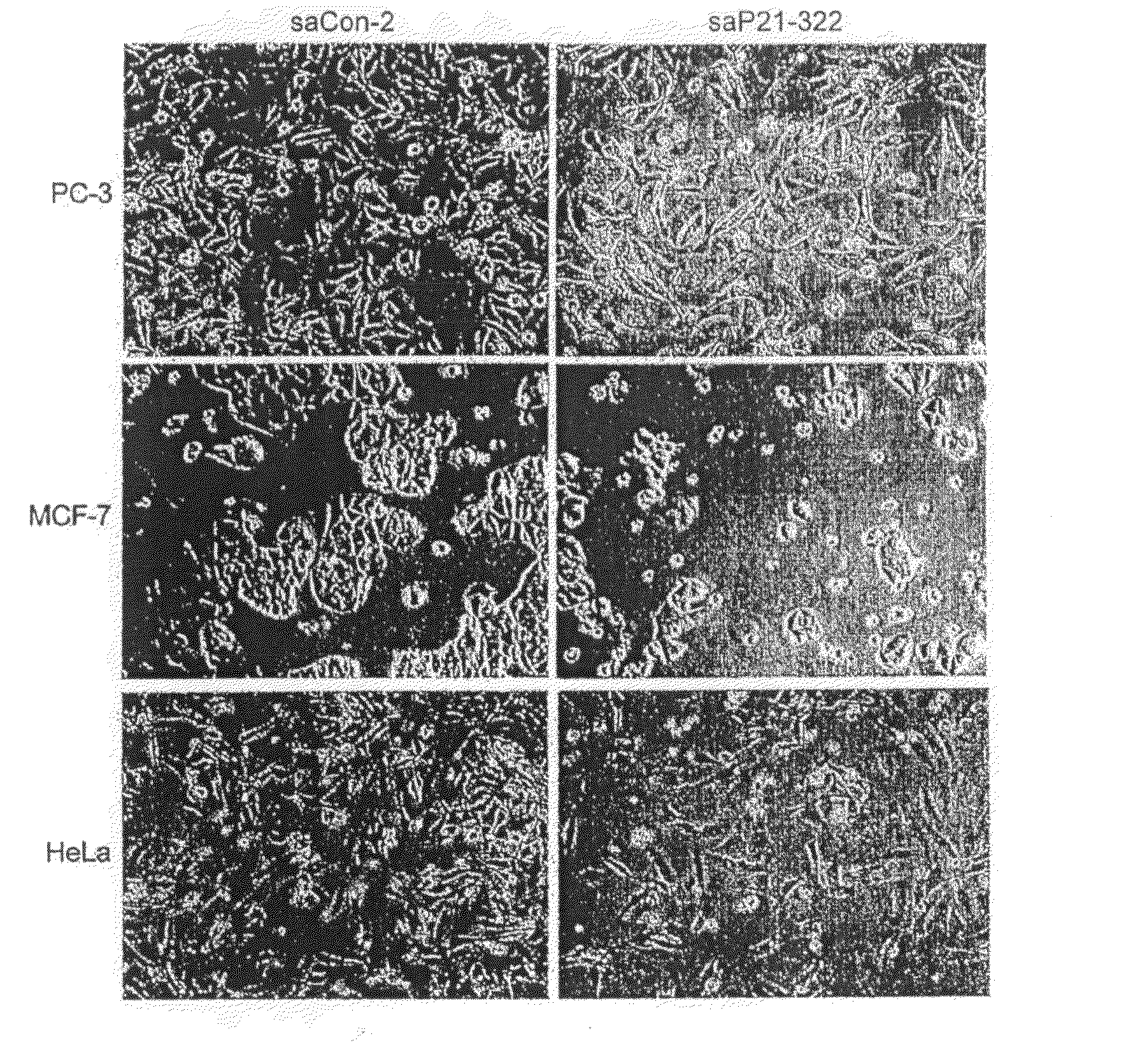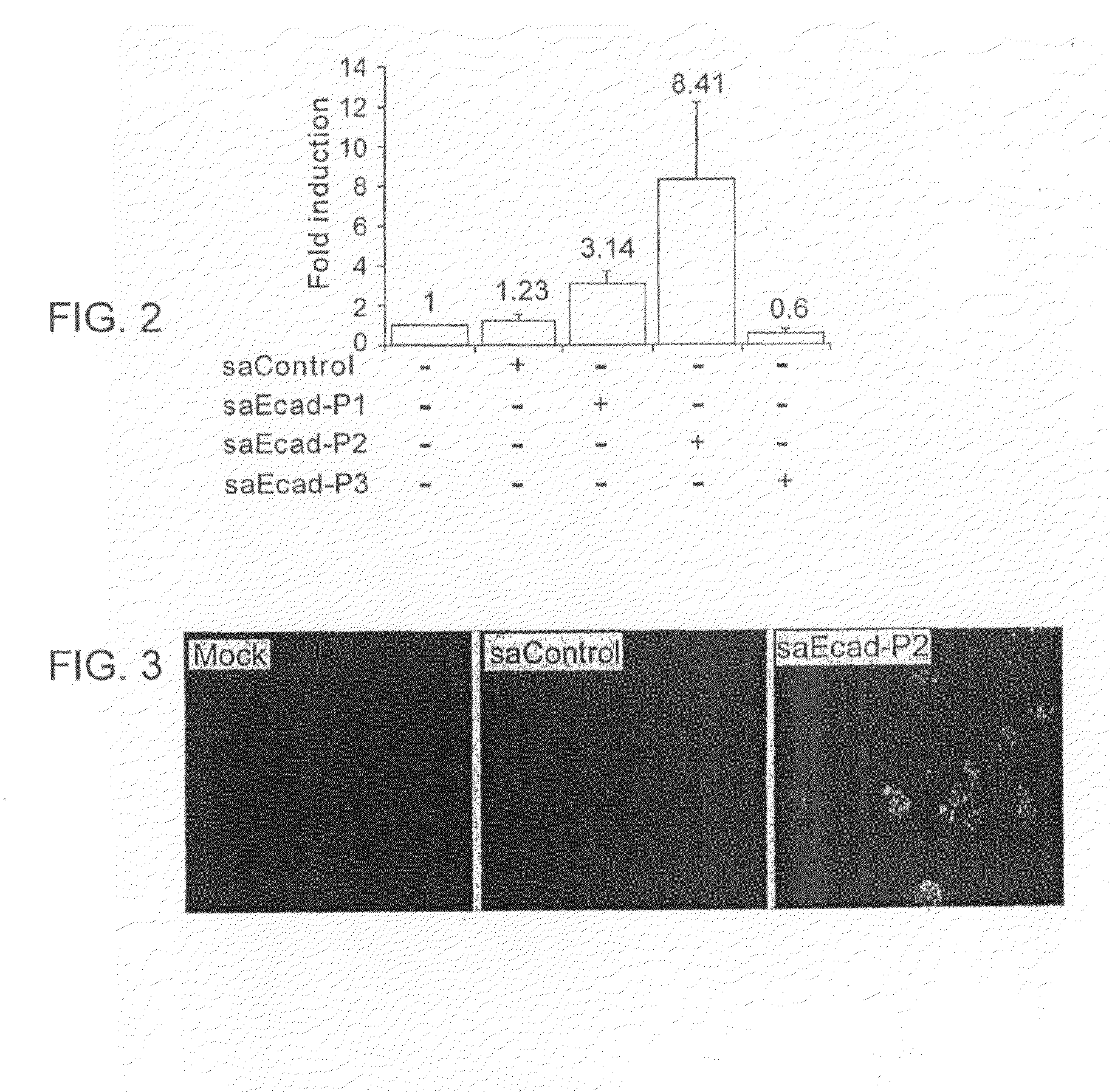Small Activating RNA Molecules and Methods of Use
- Summary
- Abstract
- Description
- Claims
- Application Information
AI Technical Summary
Benefits of technology
Problems solved by technology
Method used
Image
Examples
example 1
saRNA Targeting the E-Cadherin Gene Promoter Induce E-Cadherin mRNA and Protein Expression
[0173]To test whether the epigenetic code could be targeted to induce protein expression, two 21-nucleotide small activating RNAs (saRNAs) directed against the E-cadherin promoter were designed and chemically synthesized. One of the saRNAs (saEcad-P1) was designed to target a region upstream of the CpG island on the E-cadherin promoter (−312 / −284, relative to the transcription start site); the second saRNA (saEcad-P2) was designed to target the 5′ boundary of the CpG island (−215 / −197). A 21-nucleotide control saRNA (saControl) lacking homology to known human sequences was also designed. PC-3 cells, which are human prostate cancer cell line that has low constitutive expression of E-cadherin, were chosen for analysis.
[0174]Dramatic induction of E-cadherin protein expression in PC-3 cells transfected with saEcad-P1 or saEcad-P2 was observed within 72 hours of transfection compared to mock transfe...
example 2
saRNAs Targeting the E-Cadherin Promoter Induce Prolonged E-Cadherin Expression and Cell Death
[0176]To further characterize saRNA-directed transcriptional activation (RdTA) additional studies were performed using saEcad-P2. A dose-response experiment showed that saEcad-P2 induced E-cadherin expression at concentrations as low as 1 nM and the induction was dose-dependent at concentrations ranging from 1 to 10 nM (FIG. 4). Doses higher than 10 nM caused no further increase in E-cadherin expression. A time course experiment showed that induction of E-cadherin protein expression occurred within 48 hours of saRNA transfection and peaked at 72 hours (FIG. 5, panels A and B).
[0177]Longer periods of transfection in PC-3 cells were also tested. Mock and saControl transfected cells maintained healthy growth after transfection, while saEcad-P2 transfected cells gradually lost viability from day 5 (FIG. 6, panel C). No cells survived after 14 days. This finding is consistent with previous studi...
example 3
saRNAs Induce E-Cadherin Expression in DU145 and Hela Cells
[0179]To test whether RdTA occurs in other cells, the saRNAs were transfected into a human prostate cancer cell line DU145 and a cervical cancer cell line HeLa cells. In DU145, the E-cadherin CpG island is not methylated (FIG. 19, panel C) and the cells express normal levels of E-cadherin (FIG. 7, panel A and B). A moderate and consistent level of induction of E-cadherin protein and mRNA expression was observed in DU145 cells in response to saEcad-P1 and saEcad-P2 treatment (FIG. 7, panels A and B). In contrast, HeLa cells do not express E-cadherin and the E-cadherin CpG island is heavily methylated. saRNA transfection (72 hours) failed to induce E-cadherin expression as detected by Western blotting. It is likely that pre-established methylation of the CpG island may prevent saRNA from activating transcription. To test this hypothesis, HeLa cells were transfected in the presence of low concentrations (1-10 of 5′-aza-cytidine...
PUM
| Property | Measurement | Unit |
|---|---|---|
| Molar density | aaaaa | aaaaa |
| Concentration | aaaaa | aaaaa |
Abstract
Description
Claims
Application Information
 Login to View More
Login to View More - R&D
- Intellectual Property
- Life Sciences
- Materials
- Tech Scout
- Unparalleled Data Quality
- Higher Quality Content
- 60% Fewer Hallucinations
Browse by: Latest US Patents, China's latest patents, Technical Efficacy Thesaurus, Application Domain, Technology Topic, Popular Technical Reports.
© 2025 PatSnap. All rights reserved.Legal|Privacy policy|Modern Slavery Act Transparency Statement|Sitemap|About US| Contact US: help@patsnap.com



